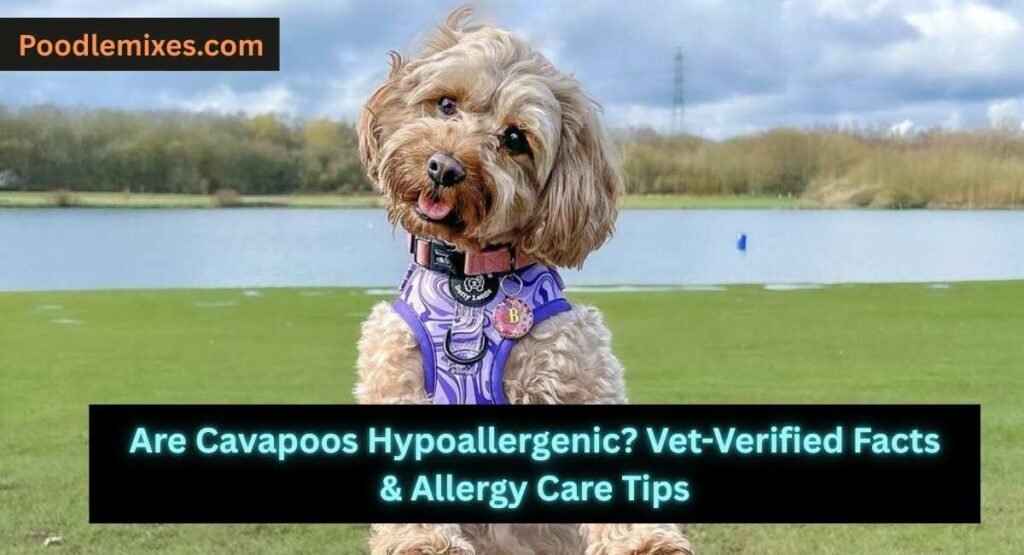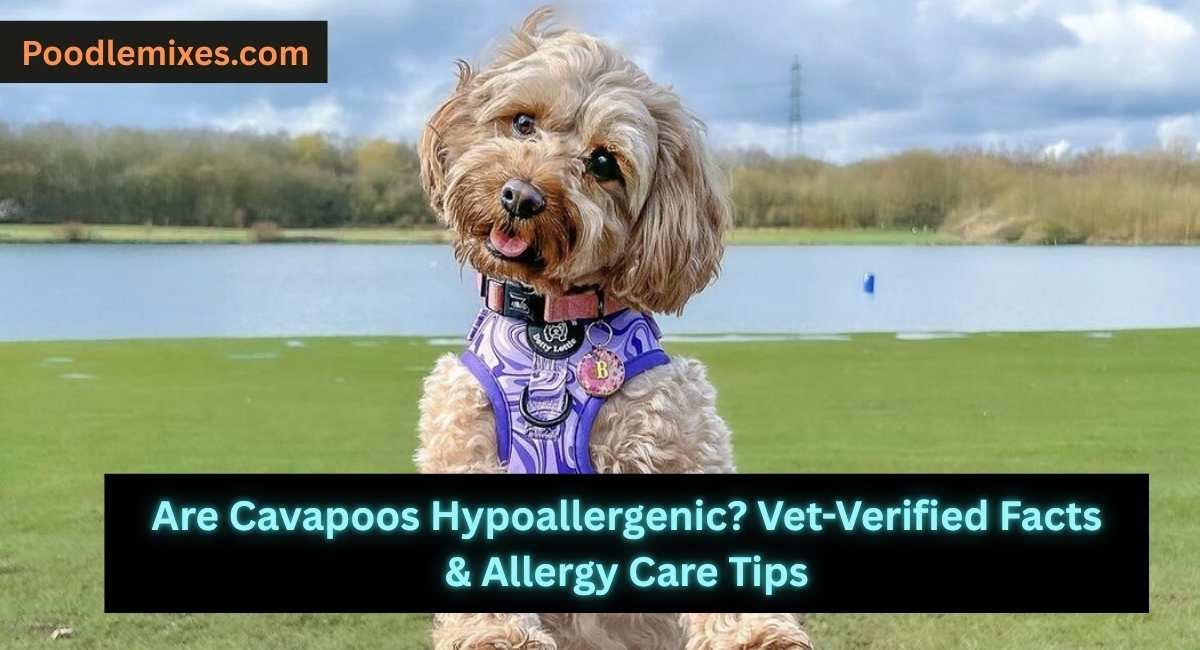Are Cavapoos hypoallergenic? Many people searching for a small, affectionate companion hope this Cavalier King Charles Spaniel and Poodle mix won’t trigger their allergies. While Cavapoos typically shed less than many breeds, research from the American College of Allergy, Asthma & Immunology confirms that no dog is 100% hypoallergenic. The reality is more complex – individual Cavapoos vary in their allergen production based on which parent they take after, their specific coat type, and grooming practices. In this comprehensive guide, we’ll examine the science of pet allergies, analyze how different Cavapoo coat types affect allergen levels, provide evidence-based allergy management strategies, and compare Cavapoos to other small poodle mixes to help you make an informed decision.
Are Cavapoos Hypoallergenic?
Are Cavapoos hypoallergenic? The accurate answer is: not entirely, but they can be a suitable choice for some allergy sufferers compared to many other small breeds. According to the American Lung Association, pet allergies are caused by proteins found in dog dander (dead skin cells), saliva, and urine – not simply fur. These microscopic proteins, primarily Can f 1 and Can f 2, become airborne and trigger allergic reactions in sensitive individuals.
A comprehensive study published in the Journal of Allergy and Clinical Immunology (2011) examined allergen levels in homes with various dog breeds, including those marketed as “hypoallergenic.” The research revealed no significant difference in overall home allergen levels between hypoallergenic and non-hypoallergenic breeds. However, individual dogs within breeds showed considerable variation, with some Cavapoos producing notably fewer allergens than others, particularly those inheriting the Poodle’s tightly curled, low-shedding coat.

What Does Hypoallergenic Really Mean in Dogs?
The term “hypoallergenic” in dogs refers to breeds that are less likely to trigger allergic reactions – not breeds that are completely allergen-free. According to the AKC’s Hypoallergenic Dog Guide, this widespread consumer misunderstanding leads many to believe certain breeds won’t cause any allergic response. The veterinary definition is more accurate: hypoallergenic breeds typically produce fewer allergens or have coat structures that trap allergens rather than releasing them into the environment.
The 2011 JACI study specifically noted: “Levels of dog allergen in homes do not differ significantly by breed label ‘hypoallergenic’.” This finding underscores that breed labels alone don’t guarantee allergy relief. Instead, individual factors like coat type, grooming frequency, and the specific dog’s allergen production levels are more predictive of allergic reactions.
Cavapoo Coat Types and Allergen Impact
Cavapoos inherit diverse coat genetics from their Poodle and Cavalier King Charles Spaniel parents, resulting in three primary coat types that significantly influence allergen production and distribution:
| Coat Type | Shedding Level | Dander Control | Allergy Risk (Relative) |
|---|---|---|---|
| Curly (more Poodle) | Very Low | Excellent | Lower |
| Wavy (mix) | Low-Moderate | Good | Medium |
| Straight (Cavalier-type) | Moderate | Fair | Higher |
According to VCA Animal Hospitals, the curly or wool coat (most similar to Poodle fur) effectively traps dander close to the skin rather than releasing it into the environment. This coat type requires professional grooming every 4-6 weeks but provides optimal allergen control. The fleece or wavy coat offers good allergen control with moderate grooming requirements. The straight or silky coat, resembling the Cavalier parent, sheds more regularly and releases more dander into living spaces.
Generation significantly impacts coat type: F1B Cavapoos (75% Poodle, 25% Cavalier) typically display curlier coats and lower allergen production than F1 Cavapoos (50/50 mix). The smaller size of Cavapoos compared to larger doodles also means less overall dander production, which can benefit allergy sufferers.
Allergy Considerations for Cavapoo Owners
The suitability of a Cavapoo for allergy sufferers depends primarily on the individual’s allergy severity and the specific dog’s characteristics. Those with mild pet allergies often tolerate Cavapoos well, especially curly or wavy-coated varieties. However, individuals with severe asthma or intense allergic reactions may still experience symptoms even with low-shedding Cavapoos.
Research from the National Institutes of Health published on NCBI demonstrates that allergen production varies more between individual dogs than between breeds. This variability means that for people asking “are Cavapoos hypoallergenic,” the reality is that it depends on your immune sensitivity and the dog’s specific coat genetics. The study found that individual dogs can produce vastly different allergen levels, with some producing up to 100 times more allergens than others within the same breed.
Pre-adoption allergy testing is crucial. Many reputable Cavapoo breeders now offer extended visits where prospective owners can spend several hours with puppies or parent dogs to assess their allergic response before committing to adoption.
Tips to Reduce Allergic Reactions With Cavapoos
Based on veterinary expertise and EPA Indoor Air Quality guidelines, here are proven strategies to minimize allergen exposure with Cavapoos:
Grooming Protocol:
- Professional grooming every 4-6 weeks (AKC grooming standards recommend this frequency for poodle-type coats in small breeds)
- Daily brushing to prevent matting and remove loose dander
- Bi-weekly baths with veterinarian-approved hypoallergenic shampoo
Environmental Management:
- Install HEPA air filters throughout living spaces (EPA recommends filters rated MERV 11 or higher)
- Use HEPA vacuum cleaners on all surfaces 2-3 times weekly
- Wash dog bedding and blankets weekly in hot water (minimum 130°F)
- Designate bedrooms as pet-free zones for allergen-free sleep
Medical Support:
- Schedule quarterly vet check-ins to monitor skin health and prevent conditions that increase dander
- Consult an allergist about immunotherapy options
- Use prescribed allergy medications preventively during high-allergen seasons
Daily Practices:
- Keep Cavapoos off upholstered furniture where allergens accumulate
- Use allergen-reducing pet wipes daily, especially after outdoor activities
- Wash hands immediately after handling or playing
- Change clothing after grooming sessions
Other Poodle Mixes Often Considered “Hypoallergenic”
Cavapoos aren’t the only small poodle crosses marketed as hypoallergenic. Here’s how they compare:
| Breed | Coat | Shedding | Allergy Friendliness* |
|---|---|---|---|
| Cavapoo | Curly/Wavy | Low | Moderate-High |
| Maltipoo | Curly/Wavy | Very Low | High |
| Yorkipoo | Curly/Wavy | Very Low | High |
| Cockapoo | Curly | Low | Moderate-High |
| Shih-poo | Curly/Wavy | Low | Moderate-High |
| Schnoodle (toy) | Curly | Very Low | High |
*Allergy Friendliness = relative chance of being allergy-manageable, not allergy-free. Individual results vary significantly.
Cavapoos often rank well among small poodle mixes for allergy sufferers due to their moderate size and generally calm temperament, which can mean less dander spread through activity. Their affectionate nature makes them excellent therapy dogs, though close contact requires careful allergen management.
Conclusion
So, are Cavapoos hypoallergenic? While no dog is fully hypoallergenic, thoughtful care, grooming, and coat selection can make Cavapoos far more manageable for many allergy-sensitive owners. The key understanding is that “hypoallergenic” indicates lower allergen production potential, not complete allergen absence.
Success with a Cavapoo depends on selecting the right coat type (preferably curly or wavy), maintaining rigorous grooming routines, implementing environmental controls, and realistically assessing your allergy severity. We strongly recommend consulting with both an allergist for personalized medical advice and responsible breeders who understand coat genetics and provide health-tested puppies with predictable coat types. Many allergy sufferers successfully share their homes with Cavapoos, finding these affectionate, intelligent companions worth the extra grooming effort. However, this success requires commitment to ongoing management strategies and realistic expectations about what “hypoallergenic” truly means in practice.
Do Cavapoos shed a lot?
Shedding varies by coat type and generation. Curly-coated Cavapoos shed minimally, with loose hair typically caught in their coat. Wavy-coated Cavapoos shed lightly, while straight-coated varieties shed more noticeably. Even “non-shedding” Cavapoos lose some hair, but significantly less than their Cavalier King Charles Spaniel parent.
Are F1B Cavapoos better for allergies?
Generally yes. F1B Cavapoos have 75% Poodle genetics, typically resulting in curlier, less-shedding coats that produce fewer airborne allergens. They’re often recommended over F1 Cavapoos (50% Poodle) for allergy sufferers. However, spending time with the individual puppy before adoption remains essential.
Can allergy sufferers live with a Cavapoo?
Many can successfully, but it depends on allergy severity and management commitment. Mild to moderate allergy sufferers often thrive with properly groomed curly or wavy-coated Cavapoos. Severe allergy sufferers should undergo allergy testing, spend extended time with the specific dog, and consult their allergist about comprehensive management strategies.
How much do Cavapoos cost to groom for allergy management?
Professional grooming every 4-6 weeks typically costs $50-100 per session, depending on location and coat condition. This regular grooming is essential for allergen control. Budget approximately $600-1,200 annually for professional grooming, plus costs for quality brushes and hypoallergenic shampoos for home maintenance.
